The global marine toxin market is valued at USD 473.4 million in 2025 and is set to reach USD 763.8 million by 2035, recording an absolute increase of USD 290.4 million over the forecast period. This translates into a total growth of 61.3%, with the market forecast to expand at a CAGR of 4.9% between 2025 and 2035. The market size is expected to grow by approximately 1.6X during the same period, supported by increasing demand for food safety testing solutions, growing awareness of harmful algal blooms, and rising applications across government food control, shellfish monitoring, and third-party testing segments.
The global marine toxin market represents a critical segment within the food safety testing and environmental monitoring industry, driven by the superior detection capabilities of marine toxin testing products and the diverse functional properties of various toxin detection types. These specialized testing products are produced through precision analytical processes, providing consistent safety standards and standardized performance characteristics for various food safety, environmental monitoring, and public health applications including shellfish testing, water quality assessment, and specialized toxicological analysis operations. The processing mechanism enables controlled toxin detection development, making these products particularly suitable for food safety professionals and applications requiring specific contamination monitoring characteristics.
The market encompasses various toxin classes, source origins, and specialized testing methods tailored for specific safety requirements. Modern marine toxin testing production incorporates advanced analytical technology, detection optimization, and enhanced testing techniques that can deliver consistent quality across variable toxin formulations while maintaining safety integrity over extended testing periods. The integration of quality control systems, regulatory compliance protocols, and standardized testing parameters has further enhanced the value proposition of these testing materials among food safety manufacturers seeking reliable detection performance and consistent safety outcomes.
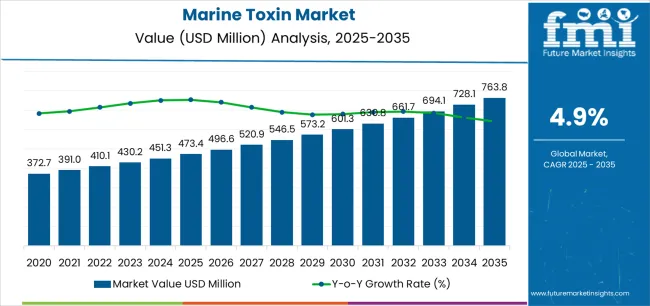
Between 2025 and 2030, the marine toxin market is projected to expand from USD 473.4 million to USD 611.7 million, resulting in a value increase of USD 138.3 million, which represents 47.6% of the total forecast growth for the decade. This phase of development will be shaped by increasing food safety adoption, rising demand for alternative testing solutions, and growing availability of premium marine toxin testing varieties across government and industry channels.
Between 2030 and 2035, the market is forecast to grow from USD 611.7 million to USD 763.8 million, adding another USD 152.1 million, which constitutes 52.4% of the ten-year expansion. This period is expected to be characterized by the advancement of specialty marine toxin testing applications, the development of enhanced testing materials for safety improvement, and the expansion of certified marine toxin testing availability across diverse food safety and environmental segments. The growing emphasis on rapid detection and advanced safety processing will drive demand for premium marine toxin testing varieties with enhanced functional properties, improved detection characteristics, and superior performance profiles in specialized safety applications.
Between 2020 and 2024, the marine toxin market experienced steady growth, driven by increasing awareness of food safety benefits and growing recognition of marine toxin testing's effectiveness in safety applications following extensive public health campaigns. The market developed as manufacturers recognized the advantages of marine toxin testing over traditional safety alternatives in contamination-sensitive applications and began seeking specialized products designed for specific detection and safety requirements. Technological advancement in analytical technology and regulatory compliance began emphasizing the critical importance of maintaining safety integrity while enhancing functional performance and improving detection across diverse marine toxin testing applications.
| Metric | Value |
|---|---|
| Estimated Value in (2025E) | USD 473.4 million |
| Forecast Value in (2035F) | USD 763.8 million |
| Forecast CAGR (2025 to 2035) | 4.9% |
From 2030 to 2035, the market is forecast to grow from USD 611.7 million to USD 763.8 million, adding another USD 152.1 million, which constitutes 52.4% of the ten-year expansion. This period is expected to be characterized by the advancement of specialized processing techniques in testing production systems, the integration of quality enhancement protocols for optimal safety retention, and the development of customized testing formulations for high-performance safety applications. The growing emphasis on material functionality and product reliability will drive demand for premium varieties with enhanced processing capabilities, improved storage stability, and superior safety performance characteristics.
Between 2020 and 2024, the marine toxin market experienced robust growth, driven by increasing awareness of alternative safety benefits and growing recognition of specialized testing systems' effectiveness in supporting diverse safety operations across government facilities and specialty industry environments. The market developed as users recognized the potential for marine toxin testing products to deliver functional advantages while meeting modern requirements for rapid detection and reliable safety performance. Technological advancement in processing optimization and quality enhancement began emphasizing the critical importance of maintaining material consistency while extending product stability and improving user satisfaction across diverse marine toxin testing applications.
Market expansion is being supported by the increasing global emphasis on food safety compliance and the corresponding shift toward alternative testing systems that can provide superior detection characteristics while meeting safety requirements for advanced testing solutions and cost-effective contamination monitoring options. Modern food safety manufacturers are increasingly focused on incorporating testing materials that can enhance safety performance while satisfying demands for consistent, precisely controlled toxin detection and optimized safety profiles. Marine toxin testing's proven ability to deliver safety excellence, functional versatility, and diverse application possibilities makes them essential materials for safety-focused professionals and quality-focused food safety testing manufacturers.
The growing emphasis on rapid detection and advanced safety processing is driving demand for high-performance marine toxin testing systems that can support distinctive safety outcomes and comprehensive detection benefits across government applications, shellfish industry operations, and specialty testing laboratory manufacturing. Safety preference for testing solutions that combine functional excellence with advanced processing methods is creating opportunities for innovative implementations in both traditional and emerging safety applications. The rising influence of environmental monitoring and alternative safety approaches is also contributing to increased adoption of marine toxin testing solutions that can provide authentic functional benefits and reliable detection characteristics.
The market is segmented by toxin class, source origin, application, and end user. By toxin class, the market is divided into paralytic shellfish toxins (PSTs), neurotoxic shellfish toxins (NSTs), amnesic shellfish toxins (ASTs), diarrhetic shellfish toxins (DSTs), azaspiracids (AZAs), yessotoxins (YTXs), pectenotoxins (PTXs), and others. Based on source origin, the market is categorized into dinoflagellates, diatoms, cyanobacteria, and bacterial symbionts. By application, the market includes food safety compliance & release testing, environmental & HAB monitoring, clinical & public health toxicology, reference standards & proficiency testing, and R&D & drug discovery. By end user, the market encompasses government food control & public health labs, shellfish monitoring programs & aquaculture operators, third-party food testing laboratories, hospitals/poison centers/clinical toxicology labs, and academic & government research institutes.
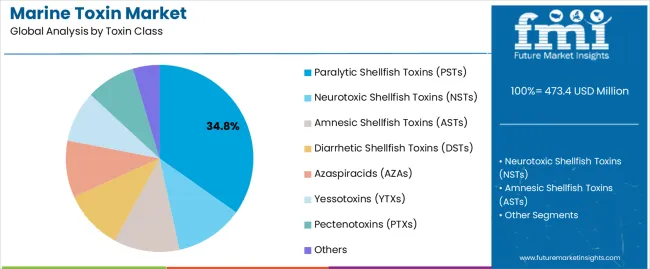
The paralytic shellfish toxins (PSTs) segment is projected to account for 34.8% of the marine toxin market in 2025, reaffirming its position as the leading toxin class category. Food safety manufacturers and testing professionals increasingly utilize PST testing technologies for their superior detection characteristics, established safety properties, and essential functionality in diverse testing applications across multiple safety sectors. PST testing's proven performance characteristics and established cost-effectiveness directly address user requirements for reliable detection control and optimal processing precision in government and specialty industry applications.
This toxin class segment forms the foundation of modern food safety testing patterns, as it represents the testing type with the greatest safety versatility and established compatibility across multiple testing systems. Food safety industry investments in alternative analytical technology and safety optimization continue to strengthen adoption among precision-focused manufacturers. With processors prioritizing testing reliability and functional consistency, PST testing systems align with both performance objectives and safety requirements, making them the central component of comprehensive food safety monitoring strategies.
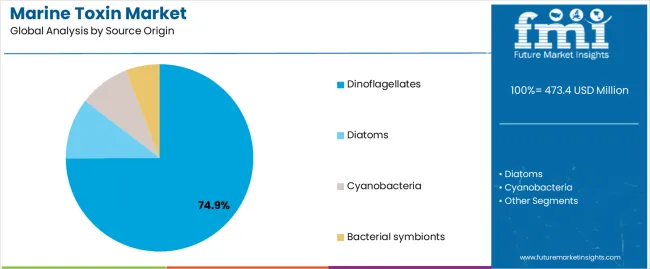
Dinoflagellates is projected to represent 74.9% of the marine toxin market in 2025, underscoring its important role as a key source origin for performance-focused users seeking superior contamination identification and enhanced safety credentials. Testing facilities and monitoring operations prefer dinoflagellate-based testing for their established performance characteristics, proven detection development, and ability to maintain exceptional safety precision while supporting versatile application coverage during diverse testing activities. Positioned as essential source origins for quality-focused safety processors, dinoflagellate offerings provide both functional excellence and safety optimization advantages.
The segment is supported by continuous improvement in analytical technology and the widespread availability of established performance standards that enable quality assurance and premium positioning at the safety level. Testing facilities are optimizing source origin selections to support application-specific requirements and comprehensive safety strategies. As analytical technology continues to advance and facilities seek consistent source origin performance, dinoflagellate applications will continue to drive market growth while supporting operational efficiency and quality optimization strategies.
The marine toxin market is advancing rapidly due to increasing food safety adoption and growing need for alternative testing solutions that emphasize superior detection performance across safety segments and specialty monitoring applications. The market faces challenges, including competition from other alternative testing types, price volatility in raw analytical materials, and processing complexity considerations affecting development costs. Innovation in analytical technology enhancement and specialized testing formulations continues to influence market development and expansion patterns.
The growing adoption of marine toxin testing with rapid certification and accuracy positioning is enabling safety companies to develop testing products that provide distinctive detection benefits while commanding premium pricing and enhanced safety appeal characteristics. Rapid applications provide superior market positioning while allowing more sophisticated product differentiation features across various safety categories. Safety companies are increasingly recognizing the market advantages of accurate testing positioning for comprehensive safety outcomes and premium-focused safety marketing.
Modern marine toxin testing manufacturers are incorporating advanced environmental enhancement, performance improvement capabilities, and detection supplementation systems to enhance product functionality, improve safety effectiveness, and meet consumer demands for enhanced monitoring solutions. These systems improve product performance while enabling new applications, including specialty safety programs and specialized monitoring protocols. Advanced performance integration also allows manufacturers to support premium product positioning and safety assurance beyond traditional testing performance requirements.
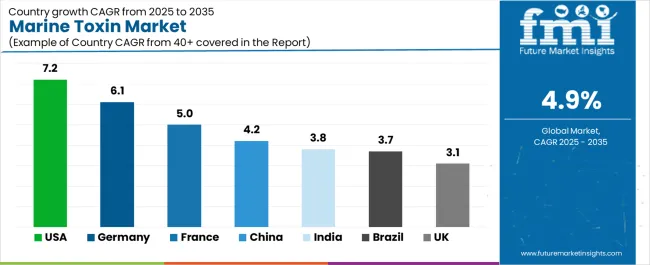
| Country | CAGR (2025 to 2035) |
|---|---|
| USA | 7.2% |
| Germany | 6.1% |
| France | 5.0% |
| China | 4.2% |
| India | 3.8% |
| Brazil | 3.7% |
| UK | 3.1% |
The marine toxin market is experiencing robust growth globally, with USA leading at a 7.2% CAGR through 2035, driven by the expanding food safety testing sector, growing environmental monitoring adoption, and increasing adoption of marine toxin testing materials. Germany follows at 6.1%, supported by rising food safety technology capabilities, expanding testing industry, and growing acceptance of toxin testing materials. France shows growth at 5.0%, emphasizing established safety standards and comprehensive testing development. China records 4.2%, focusing on food safety industry modernization and testing market growth. India demonstrates 3.8% growth, prioritizing advanced testing technologies and safety-focused food products.
The report covers an in-depth analysis of 40+ countries, with top-performing countries highlighted below.
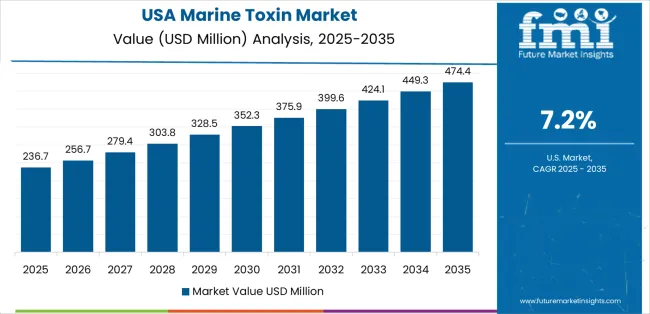
Revenue from marine toxin consumption and sales in USA is projected to exhibit exceptional growth with a CAGR of 7.2% through 2035, driven by the country's rapidly expanding food safety testing sector, favorable safety policies toward analytical testing, and initiatives promoting toxin testing development across major food safety regions. USA's position as a global food safety leader and increasing focus on processed testing materials are creating substantial demand for high-quality marine toxin testing in both domestic and international markets. Major food safety companies and testing distributors are establishing comprehensive toxin testing production capabilities to serve growing demand and emerging safety opportunities.
Revenue from marine toxin products in Germany is expanding at a CAGR of 6.1%, supported by rising domestic food safety consumption, growing analytical testing technology adoption, and expanding testing distributor capabilities. The country's developing food safety infrastructure and increasing investment in testing technologies are driving demand for marine toxin testing across both traditional and modern safety applications. International testing companies and domestic processors are establishing comprehensive operational networks to address growing market demand for alternative toxin testing products and efficient testing processing solutions.
Revenue from marine toxin products in France is projected to grow at a CAGR of 5.0% through 2035, supported by the country's mature food safety processing standards, established analytical testing regulations, and leadership in specialty toxin testing technology. France's sophisticated food safety standards and strong support for alternative testing systems are creating steady demand for both traditional and innovative toxin testing varieties. Leading testing manufacturers and specialty distributors are establishing comprehensive operational strategies to serve both domestic markets and growing export opportunities.
Revenue from marine toxin products in China is projected to grow at a CAGR of 4.2% through 2035, driven by the country's emphasis on food safety industry development, testing processing growth, and growing distributor capabilities. Chinese manufacturers and processing facilities consistently seek quality-focused testing that enhance product performance and support processing excellence for both traditional and modern food safety applications. The country's position as an Asian food safety leader continues to drive innovation in specialized toxin testing applications and food safety processing standards.
Revenue from marine toxin products in India is projected to grow at a CAGR of 3.8% through 2035, supported by established food safety standards, mature testing markets, and emphasis on analytical alternatives across food safety and environmental sectors. Indian manufacturers and specialty processors prioritize quality testing and consistent performance, creating steady demand for premium toxin testing solutions. The country's comprehensive market innovation and established food safety practices support continued development in specialized applications.
Revenue from marine toxin products in Brazil is projected to grow at a CAGR of 3.7% through 2035, supported by established food safety standards, mature testing markets, and emphasis on analytical alternatives across food safety and aquaculture sectors. Brazilian manufacturers and specialty processors prioritize quality testing and consistent performance, creating steady demand for premium toxin testing solutions. The country's comprehensive market maturity and established food safety practices support continued development in specialized applications.
Revenue from marine toxin products in the UK is projected to grow at a CAGR of 3.1% through 2035, supported by the country's emphasis on testing quality, food safety excellence, and advanced processing technology integration requiring efficient testing solutions. British food safety facilities and quality-focused operations prioritize technical performance and safety precision, making specialized toxin testing essential materials for both traditional and modern food safety applications. The country's comprehensive food safety leadership and advancing quality patterns support continued market expansion.
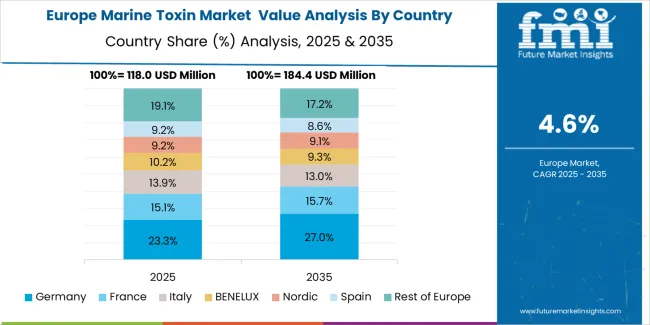
The Europe marine toxin market is projected to grow from USD 132.9 million in 2025 to USD 207.6 million by 2035, registering a CAGR of 4.6% over the forecast period. Germany is expected to maintain its leadership position with a 27.7% market share in 2025, expanding to 32.0% by 2035, supported by its advanced food safety infrastructure and major testing hubs including Berlin and Munich.
France follows with a 17.1% share in 2025, projected to reach 17.7% by 2035, driven by comprehensive food safety modernization programs and analytical testing initiatives. Italy holds a 12.0% share in 2025, maintaining 12.0% by 2035 due to steady testing adoption. Spain commands an 8.2% share declining to 7.8% by 2035, while BENELUX accounts for 6.0% declining to 5.4% by 2035. The Rest of Western Europe region is anticipated to maintain significant presence, with its collective share declining from 25.6% to 22.3% by 2035, while Nordic countries hold steady at 3.4% to 2.8%, attributed to specialized food safety testing adoption and established contamination monitoring programs.
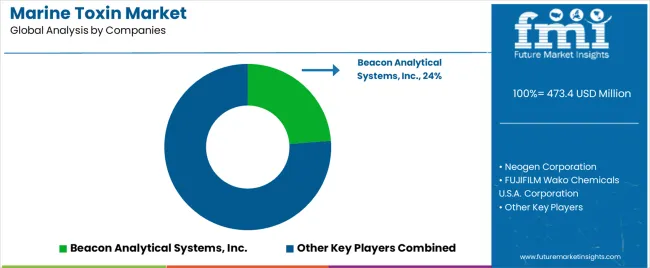
The marine toxin market is characterized by competition among established analytical testing manufacturers, specialized toxin testing companies, and integrated food safety providers. Companies are investing in advanced analytical technologies, specialized processing engineering, product innovation capabilities, and comprehensive distribution networks to deliver consistent, high-quality, and reliable marine toxin testing products. Innovation in testing efficiency optimization, quality control advancement, and safety-focused product development is central to strengthening market position and customer satisfaction.
Beacon Analytical Systems leads the market with 23.8% share with a strong focus on analytical technology innovation and comprehensive food safety solutions, offering safety and specialty systems with emphasis on quality excellence and detection heritage. Neogen Corporation provides integrated advanced testing solutions with a focus on food safety market applications and functional testing networks. FUJIFILM Wako Chemicals USA Corporation delivers comprehensive toxin testing products with a focus on safety positioning and analytical quality. Gold Standard Diagnostics specializes in analytical-based testing systems with an emphasis on food safety applications. LGC Standards focuses on comprehensive toxin testing processing with advanced analytical technology and safety positioning capabilities. The combined other key players represent 76.2% of the market, indicating significant competition and market fragmentation among emerging testing providers and specialized food safety companies.
| Items | Values |
|---|---|
| Quantitative Units (2025) | USD 473.4 million |
| Toxin Class | Paralytic Shellfish Toxins (PSTs), Neurotoxic Shellfish Toxins (NSTs), Amnesic Shellfish Toxins (ASTs), Diarrhetic Shellfish Toxins (DSTs), Azaspiracids (AZAs), Yessotoxins (YTXs), Pectenotoxins (PTXs), Others |
| Source Origin | Dinoflagellates, Diatoms, Cyanobacteria, Bacterial symbionts |
| Application | Food Safety Compliance & Release Testing, Environmental & HAB Monitoring, Clinical & Public Health Toxicology, Reference Standards & Proficiency Testing, R&D & Drug Discovery |
| End User | Government Food Control & Public Health Labs, Shellfish Monitoring Programs & Aquaculture Operators, Third-Party Food Testing Laboratories, Hospitals/Poison Centers/Clinical Toxicology Labs, Academic & Government Research Institutes |
| Regions Covered | North America, Europe, Asia-Pacific, Latin America, Middle East & Africa |
| Countries Covered | USA, UK, Germany, France, Japan, South Korea, China, India, Brazil, and 40+ countries |
| Key Companies Profiled | Beacon Analytical Systems, Neogen Corporation, FUJIFILM Wako Chemicals, Gold Standard Diagnostics, LGC Standards, and other leading marine toxin companies |
| Additional Attributes | Dollar sales by toxin class, source origin, application, end user, and region; regional demand trends, competitive landscape, technological advancements in testing processing, quality optimization initiatives, safety enhancement programs, and premium product development strategies |
The global marine toxin market is estimated to be valued at USD 473.4 million in 2025.
The market size for the marine toxin market is projected to reach USD 763.8 million by 2035.
The marine toxin market is expected to grow at a 4.9% CAGR between 2025 and 2035.
The key product types in marine toxin market are paralytic shellfish toxins (psts) , neurotoxic shellfish toxins (nsts), amnesic shellfish toxins (asts), diarrhetic shellfish toxins (dsts), azaspiracids (azas), yessotoxins (ytxs), pectenotoxins (ptxs) and others.
In terms of source origin, dinoflagellates segment to command 74.9% share in the marine toxin market in 2025.






Full Research Suite comprises of:
Market outlook & trends analysis
Interviews & case studies
Strategic recommendations
Vendor profiles & capabilities analysis
5-year forecasts
8 regions and 60+ country-level data splits
Market segment data splits
12 months of continuous data updates
DELIVERED AS:
PDF EXCEL ONLINE
Marine Thermal Fluid Heaters Market Size and Share Forecast Outlook 2025 to 2035
Marine Nutraceutical Market Size and Share Forecast Outlook 2025 to 2035
Marine Power Battery System Market Size and Share Forecast Outlook 2025 to 2035
Marine Life Raft Market Size and Share Forecast Outlook 2025 to 2035
Marine Trenchers Market Size and Share Forecast Outlook 2025 to 2035
Marine Electronics Tester Market Size and Share Forecast Outlook 2025 to 2035
Marine Steering Systems Market Size and Share Forecast Outlook 2025 to 2035
Marine & Dock Gangways Market Size and Share Forecast Outlook 2025 to 2035
Marine HVAC System Market Size and Share Forecast Outlook 2025 to 2035
Marine Outboard Engines Market Size and Share Forecast Outlook 2025 to 2035
Marine Stabilizers Market Size and Share Forecast Outlook 2025 to 2035
Marine Fuel Injection System Market Size and Share Forecast Outlook 2025 to 2035
Marine Energy Market Size and Share Forecast Outlook 2025 to 2035
Marine Propulsion Engine Market Size and Share Forecast Outlook 2025 to 2035
Marine Protein Hydrolysate Market Size and Share Forecast Outlook 2025 to 2035
Marine Fin Stabilizer Market Size and Share Forecast Outlook 2025 to 2035
Marine Extract Market Size and Share Forecast Outlook 2025 to 2035
Marine Squalene Alternatives Market Size and Share Forecast Outlook 2025 to 2035
Marine Prebiotics Market Size and Share Forecast Outlook 2025 to 2035
Marine Collagen-Based Products Market Analysis - Size, Share, and Forecast Outlook 2025 to 2035

Thank you!
You will receive an email from our Business Development Manager. Please be sure to check your SPAM/JUNK folder too.
Chat With
MaRIA